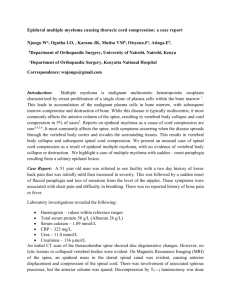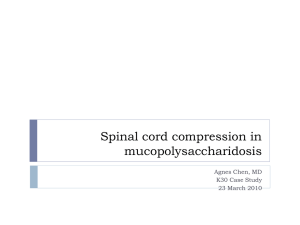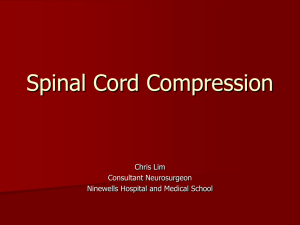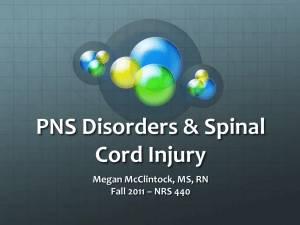Spinal Cord Compression - American Association of Critical
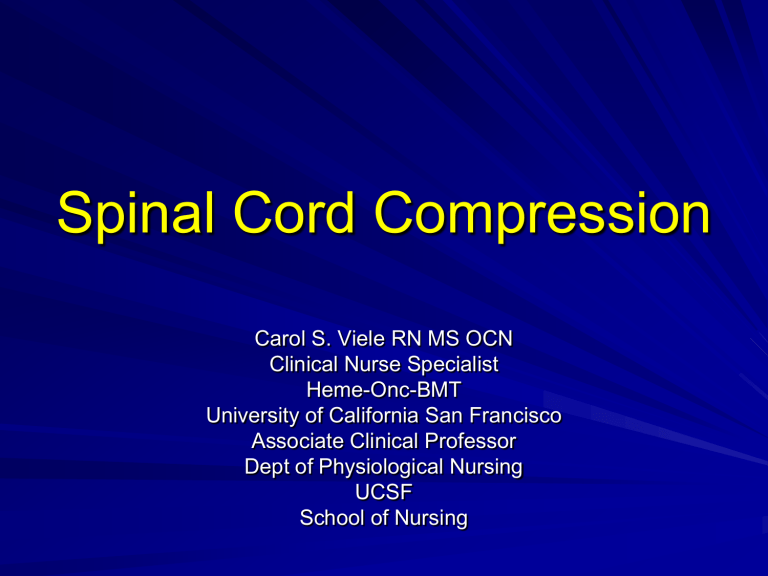
Spinal Cord Compression
Carol S. Viele RN MS OCN
Clinical Nurse Specialist
Heme-Onc-BMT
University of California San Francisco
Associate Clinical Professor
Dept of Physiological Nursing
UCSF
School of Nursing
Objectives
At the completion of this presentation the participant will be able to:
– Describe the most common cancers associated with cord compression
– Identify at least 2 symptoms associated with cord compression
– Describe the most appropriate nursing interventions for cord compression
Definition/Frequency
A mass effect from the tumor with associated edema which results in ischemia and neural damage to the spinal cord
10% of all patients with cancer will develop this complication
Occurrence
The most common source of cord compression is metastasis to the epidural space with or without bony involvement
Tumors can also through the reach the epidural space by direct extension through the intervertebral foramen
Some tumors occur in the cord itself
Etiology
Tumor types
– Breast, (Number 1 in women)
– Lung
– Kidney
– Myeloma
– Prostate
– Melanoma
– Gastrointestinal tumors
– Lynphoma
Level of Involvement
Cervical area 10%
Thoracic area 70%
Lumbosacral 20%
Symptoms
Back pain is usually the first symptom
95% of patients with a cord compression experience back pain
Pain will precede other symptoms by weeks to months
Early cord compression may be asymptomatic
Manifestations
Pain
– Localized
– Radicular
– Severity
– Position changes
– Cough
– Weightbearing
– Valsalva maneuver
Manifestations
Weakness 75-85%
– May progress rapidly
– Bilateral
– Corresponds to the level of cord involvemnent
Spasticity
Hyperreflexia
Abnormal stretch reflexes
Extensor plantar response
Manifestations
Sensory loss
–Bowel dysfunction
–Bladder dysfunction
–Impotence
Diagnosis
Thorough physical examination
– Palpation
– Gentle percussion over bony areas
– Neurologic exam
Laboratory data – Increased alkaline phosphatase may indicate bony involvement
Diagnosis
Radiographs- may reveal erosion of the pedicle,
– Lytic lesions of the vertebral body
– Collapse of the vertebral body
Bone scan- 20% of scans reveal lesions missed on plain films
CT
– Used to determine extent of tumor
Diagnosis
MRI ( Tool of choice)
– Able to determine prevertebral, vertebral, extradural, intradural, extramedullary and intramedullary lesions
– Provides better anatomic visualization with sagittal and axial images of the spinal cord
Fine needle aspiration
– May provide tissue confirmation
Treatment
Criteria:
–Primary tumor type
–Level of myelopathy
–Degree of spinal block
–Potential for neurologic reversibility
Treatment
Surgery
– Radical resection if an a candidate
– Complete block
– Single lesion where complete removal is possible
– Diagnosis is uncertain
– Mild deficits
– New data supports surgery over treatment with RT if patient is a good surgical candidate
Treatment
Radiation therapy
– If not a surgical candidate
– Incomplete block
– Severe deficits
– Relapse in area of prior radiation if short survival is expected
Treatment
Radiation- often initiated as an emergency if not a surgical candidate
– Therapy
Treatment field extends 1-2 vertebral bodies above and below level of compression
3000-4000 cGy over 2-4 weeks
2/3 of patients remain stable or improve
65-75% achieve pain relief
Treatment
Steroids
– Dexamethasone
Bolus IV 10 mg
Oral 4-6 mg q 6 hours for 2 days then a slow taper
25% of patients with cord compression require maintenance to maintain neurologic function
Steroid related side effects may occur
– Hyperglycemia
– GI bleeding
– Psychosis
Treatment
Chemotherapy
– May be given in highly sensitive tumors
– Always given with other modalities
Outcome
Pretreatment ambulatory ability is the main determinant of post treatment ambulatory ability
90% of patients ambulatory before therapy are after
Only 10% of paraplegics become ambulatory after therapy
Prognosis
Median survival is 6 months if patient presents as a paraplegic
50% of patients who walk in with a cord compression are alive at 1 year
If patient was ambulatory prior to RT survival is 8-10 months
Recurrent Disease
Options
– If RT given may be a surgical candidate if survival of > 12 months predicted
– Repeat RT
Risks of repeat RT
–Radiation myelopathy
–Collateral damage
Nursing Interventions
Thorough assessment and early
MD/Provider notification of changes in
– Pain
– Sensory function
– Motor function
– Urinary function
– Bowel function
Nursing Interventions
Maintenance of functional status
– Bowel program
– Bladder program
– Skin care
– Rehabilitation services
PT
OT
Nursing Interventions
Education
–Patient
–Family
–Significant others
–Care givers
Nursing Interventions
Emotional support
–Decrease anxiety
–Referrals
Social worker
Psychologists
Psychiatrist
Chaplain
Nursing Interventions
Referrals
–Care coordination
–Case manager
–Home care
–Rehabilitation center
–Skilled nursing facility
–Hospice
References
Schulmeister, L., Gatlin, C.,( 2008) Spinal cord compression in Oncology Nursing Secrets,
Gates, R. and Fink, R. (eds) Hanley and Belfus,
Philadelphia, 546-550
Quinn, J., De Angelis, L.(2000) “Neurologic emergencies in the cancer patient”, Semin
Oncol, 27: 311- 321
Tan, S. Recognition and Treatment of Oncologic
Emergencies (2002), Journal of Infusion
Nursing,25:3, 182-188
References
www.uptodate.com
, Spinal Cord
Compression, Accessed 7/9/09





